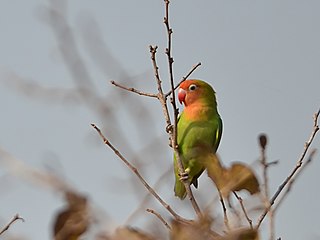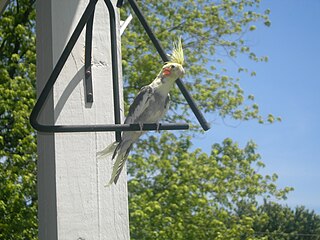
Lovebird is the common name for the genus Agapornis, a small group of parrots in the Old World parrot family Psittaculidae. Of the nine species in the genus, all are native to the African continent, with the grey-headed lovebird being native to the African island of Madagascar.

The budgerigar, also known as the common parakeet, shell parakeet or budgie, is a small, long-tailed, seed-eating parrot. Budgies are the only species in the genus Melopsittacus. Naturally, the species is green and yellow with black, scalloped markings on the nape, back, and wings. Budgies are bred in captivity with colouring of blues, whites, yellows, greys, and even with small crests. Juveniles and chicks are monomorphic, while adults are told apart by their cere colouring, and their behaviour.

The cockatiel, also known as the weero/weiro or quarrion, is a medium-sized parrot that is a member of its own branch of the cockatoo family endemic to Australia. They are prized as household pets and companion parrots throughout the world and are relatively easy to breed. As a caged bird, cockatiels are second in popularity only to the budgerigar.

The scarlet-chested parrot, known alternately as scarlet-breasted parrot, orange-throated parrot or splendid parrot, is a parrot endemic to central South Australia and inland southern Western Australia. The species is sexually dimorphic; the male has a bright blue face and scarlet chest and yellow underparts, amid overall green plumage, while the female is similar but lacks the red chest. These nomadic parakeets move readily from the Great Victoria Desert region into neighbouring areas. These interruptions are triggered by a search for more favourable conditions. They can survive quite well without access to drinking water, however, as succulent plants help meet much of their fluid requirement. They feed mainly on grass seeds and are most commonly sighted in spinifex.

The rosy-faced lovebird, also known as the rosy-collared or peach-faced lovebird, is a species of lovebird native to arid regions in southwestern Africa such as the Namib Desert. Loud and constant chirpers, these birds are very social animals and often congregate in small groups in the wild. They eat throughout the day and take frequent baths. Coloration can vary widely among populations. Plumage is identical in males and females. Lovebirds are renowned for their sleep position in which they sit side-by-side and turn their faces in towards each other. Also, females are well noted to tear raw materials into long strips, "twisty-tie" them onto their backs, and fly substantial distances back to make a nest. These birds are common in the pet industry.

Lilian's lovebird, also known as the Nyasa lovebird, is a small African parrot species of the lovebird genus. It is mainly green and has orange on its upper chest and head. It is 13 cm (5 inches) long and is the smallest parrot on mainland Africa. In captivity, it is uncommon and difficult to breed.

Fischer's lovebird is a small parrot species of the genus Agapornis. They were originally discovered in the late 19th century. They are named after German explorer Gustav Fischer.

The science of budgerigar color genetics deals with the heredity of mutations which cause color variation in the feathers of the species known scientifically as Melopsittacus undulatus. Birds of this species are commonly known by the terms 'budgerigar', or informally just 'budgie'.

The Pacific parrotlet, also known as Lesson's parrotlet, or the celestial parrotlet, is a species of small parrot in the family Psittacidae.

The science of rosy-faced lovebird colour genetics deals with the heredity of colour variation in the feathers of the species known as Agapornis roseicollis, commonly known as the rosy-faced lovebird or peach-faced lovebird.

The science of cockatiel colour genetics deals with the heredity of colour variation in the feathers of cockatiels, Nymphicus hollandicus. Colour mutations are a natural but very rare phenomenon that occur in either captivity or the wild. About fifteen primary colour mutations have been established in the species which enable the production of many different combinations. Note that this article is heavily based on the captive or companion cockatiel rather than the wild cockatiel species.

The Blue budgerigar mutation is one of approximately 30 mutations affecting the colour of budgerigars. It is part of the genetic constitution of the following recognised varieties: Skyblue, Cobalt, Mauve and Violet.
The Dilute budgerigar mutation is one of approximately 30 mutations affecting the colour of budgerigars. It is one of the constituent mutations of several recognised varieties: the Light, Dark, Olive, Grey and Suffused Yellows and the Grey and Suffused Whites.
The Clearwing budgerigar mutation is one of approximately 30 mutations affecting the colour of budgerigars. It is the underlying mutation of the Clearwing variety, often known as Yellowwings in the green series and Whitewings in the blue series. When combined with the Greywing mutation the variety is known as the Full-bodied Greywing. When combined with the Yellowface II and Opaline mutations the Rainbow variety is produced.
The Opaline budgerigar mutation is one of approximately 30 mutations affecting the colour or appearance of budgerigars. It is the underlying mutation of the Opaline variety. When combined with the Yellowface II and Clearwing mutations the Rainbow variety is produced.
The Ino budgerigar mutation is one of approximately 30 mutations affecting the colour of budgerigars. It is the underlying mutation of the Albino and Lutino varieties and, with Cinnamon, a constituent mutation of the Lacewing variety.

The Slate budgerigar mutation is one of approximately 30 mutations affecting the colour of budgerigars. It is the underlying mutation of the Slate variety.

The lutino cockatiel is one of the most popular mutations of cockatiel, with white to light-yellow feathers and orange/red cheek patches.

The Pied cockatiel is the first mutation of cockatiel colour genetics, with a mostly grey to light-yellow and white feathers and orange cheek patches.

The normal grey cockatiel, wild type cockatiel, wild cockatiel or grey cockatiel, is the origin cockatiel of all colour genetics mutations, with mostly grey feathers and orange cheek patches.



























